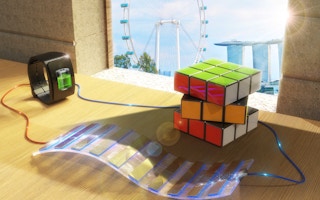Shadows have long been of little use to engineers, but researchers from the National University of Singapore (NUS) have created a device that makes use of this optical effect to generate electricity, demonstrating a novel way to harvest energy under low-light conditions.
To continue reading, subscribe to Eco‑Business.
There's something for everyone. We offer a range of subscription plans.
- Access our stories and receive our Insights Weekly newsletter with the free EB Member plan.
- Unlock unlimited access to our content and archive with EB Circle.
- Publish your content with EB Premium.
Called a shadow-effect energy generator, the device looks just like a miniature version of a silicon solar panel to most people, in that cells comprised of thin films of gold and silicon wafers are arranged on a plastic film.
But instead of tapping the sun’s energy, the generator harnesses the contrast in illumination that arises on its cells from shadow castings. This contrast induces a voltage difference between shadowed and illuminated sections of the device, resulting in an electric current, explained research team leader Assistant Professor Tan Swee Ching of NUS’ Department of Materials Science and Engineering.
The research breakthrough by the six-member team was reported in scientific journal Energy & Environmental Science last month.
Tan said: “Shadows are omnipresent, and we often take them for granted. In conventional photovoltaic or optoelectronic applications where a steady source of light is used to power devices, the presence of shadows is undesirable, since it degrades the performance of devices. In this work, we capitalised on the illumination contrast caused by shadows as an indirect source of power.”
While commercially available silicon solar cells still produce significantly higher amounts of electricity when completely illuminated, the team’s four-cell generator was found to be twice as efficient as conventional solar technology when exposed to the effect of shifting shadows, making it attractive for low-light applications such as indoor environments. And because it costs 10 times less to manufacture than solar panels available today, the device could be easily scalable and commercialised.
“Solar cells are developed to harvest sunlight under full illumination. Accordingly, if partially covered in shadow, they do not perform well, and their efficiency drops drastically. Under such weak and ambient light conditions, our device produces a higher power output, as long as there is a contrast in illumination,” Tan told Eco-Business.
Could the novel device help the world switch from climate-disrupting fossil fuels to cleaner sources of energy more quickly? Possibly, said Tan. At present, the device is geared towards applications inside homes, where it could power smaller electronics such as phones and other digital gadgets, but more research could unlock higher efficiencies and enable large-scale outdoor applications in the long term, he said.
“It took the solar industry years to bring the technology to the current state of development. This is the first device we created, and there is much work that can be done to improve it further. One day, I hope to see it produce utility-scale electricity,” Tan said. Surface treatments to trap light and other engineering methods that have been used to improve conventional solar technology could potentially boost the new generator’s performance, he said.
Eventually, densely built urban spaces, where high-rise infrastructure and even people wandering the streets cast plenty of shadows that the generator could harness, could offer opportunities to deploy the novel technology. With its performance neither affected by high temperatures nor humidity, it could be installed on all kinds of surfaces outdoors, including pavements.
On when the generator would be commercially available, Tan said it would depend on the interest that the breakthrough generates and whether more organisations join research efforts.










